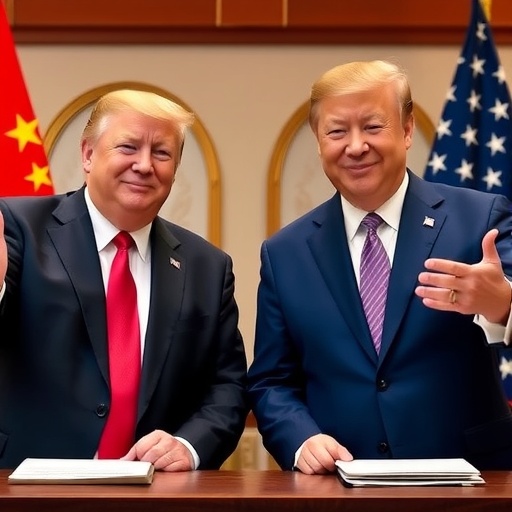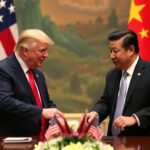US and China Nearing Historic Trade Deal as Trump-Xi Summit Looms
In a dramatic turn that could redefine global economics, the United States and China are on the verge of announcing a sweeping US-China trade agreement, with President Donald Trump and President Xi Jinping set to finalize details at an upcoming summit. Sources close to the negotiations reveal that after months of intense talks, the two superpowers have bridged key divides on tariffs, intellectual property, and market access, potentially averting a full-blown trade war that has rattled markets worldwide.
The breakthrough comes amid heightened tensions, including recent escalations in technology export restrictions and agricultural disputes. According to White House officials, the deal, if sealed, would reduce bilateral tariffs by up to 50% on $300 billion worth of goods, injecting fresh momentum into the global economy. This development marks a pivotal moment in the Trump-era negotiations, where the U.S. has pushed aggressively for fairer trade practices from Beijing.
Economists estimate that a successful trade deal could boost U.S. GDP by 0.5% annually and add over 2 million jobs, while China could see stabilized exports and eased pressures on its manufacturing sector. As the world watches, the summit—tentatively scheduled for next month in Singapore—looms as the stage for this high-stakes diplomacy.
Breakthrough on Tariffs and Intellectual Property Rights
At the heart of the emerging US-China trade pact lies a compromise on tariffs that has eluded negotiators for over a year. Under the proposed terms, both nations would roll back retaliatory duties imposed since 2018, starting with a phased reduction on industrial goods like machinery and electronics. U.S. Trade Representative Robert Lighthizer, in a recent briefing, stated, “This agreement represents a win for American workers, ensuring that our innovations aren’t stolen and our markets remain open but protected.”
Intellectual property (IP) protections form another cornerstone, addressing long-standing U.S. grievances over forced technology transfers and counterfeit goods. China has pledged to strengthen enforcement through new domestic laws, including harsher penalties for IP theft, which the U.S. International Trade Commission reports costs American firms up to $600 billion annually. In return, the U.S. has agreed to lift some restrictions on high-tech exports to China, such as semiconductors, potentially benefiting companies like Intel and Qualcomm.
Statistics underscore the urgency: Bilateral trade volume hit $659 billion in 2019 before tariffs bit, but has since dipped by 15%. Negotiators from both sides, working through marathon sessions in Geneva and Washington, have incorporated mechanisms for ongoing dispute resolution, including a bilateral commission to monitor compliance. This IP framework alone could unlock $100 billion in untapped U.S. exports over the next five years, per a Peterson Institute for International Economics analysis.
Yet, the devil is in the details. Chinese state media has highlighted Xi Jinping’s role in pushing for “mutual respect” in these talks, emphasizing that Beijing will not tolerate one-sided concessions. As one anonymous Chinese diplomat noted to Reuters, “President Xi sees this as a strategic pivot, balancing domestic reforms with international stability.”
Navigating Agricultural and Tech Flashpoints in Talks
Agriculture has emerged as a surprising linchpin in the negotiations, with the U.S. securing commitments from China to purchase an additional $50 billion in American farm products annually, including soybeans, pork, and corn. This addresses a key pain point for Midwestern farmers, who saw exports to China plummet 74% in 2018 due to retaliatory tariffs. The American Farm Bureau Federation praised the move, with President Zippy Duvall saying, “This deal puts money back in farmers’ pockets and stabilizes food supply chains globally.”
On the technology front, tensions over Huawei and 5G infrastructure have softened, with the deal outlining a “clean network” initiative where China agrees to exclude untrusted vendors from critical infrastructure projects. In exchange, the U.S. will ease some entity list designations, allowing limited trade in non-sensitive tech. This comes after the U.S. blacklisted over 100 Chinese firms last year, citing national security risks—a move that prompted Beijing to retaliate with rare earth export curbs.
Broader context reveals the stakes: China’s dominance in rare earth minerals, controlling 80% of global supply, has been a leverage point, but negotiators have agreed to joint investment in mining ventures to diversify sources. Financial data from the World Bank indicates that unresolved tech disputes could shave 1% off global growth by 2025, making these concessions vital. Trump, in a tweet last week, boasted, “Great progress with China—deals like this make America strong again!” while Xi’s foreign ministry echoed the sentiment, calling the talks “pragmatic and constructive.”
Environmental standards also weave into the fabric, with both leaders committing to green trade clauses that promote sustainable agriculture and reduce carbon-intensive manufacturing. This aligns with Xi’s “ecological civilization” agenda and Trump’s push for energy independence, potentially opening doors for U.S. LNG exports to fuel China’s shift from coal.
Global Market Ripples from the Potential Trade Pact
The anticipated trade deal is already sending shockwaves through international markets, with the Dow Jones Industrial Average surging 2.5% on rumors of a breakthrough last Friday. Asian indices, including the Shanghai Composite, followed suit, climbing 1.8%, as investors bet on restored supply chains. Currency markets reflect optimism too: The U.S. dollar strengthened against the yuan by 0.7%, signaling confidence in balanced trade flows.
Experts from Goldman Sachs project that full implementation could add $200 billion to annual global trade volume, benefiting not just the U.S. and China but allies like the EU and Japan. However, ripple effects vary: Australian miners, who gained from diverted Chinese soybean demand, may face renewed competition, while Vietnamese manufacturers could lose some edge in relocated supply chains.
In the U.S., sectors like autos and aerospace stand to gain most. Boeing, hit hard by China’s order freeze, could resume $20 billion in deliveries, while General Motors eyes expanded EV partnerships. Conversely, U.S. steel producers might see import pressures ease with tariff cuts. A Moody’s report warns of short-term volatility, estimating a 10-15% swing in commodity prices post-deal.
From Beijing’s perspective, the pact supports Xi Jinping’s dual circulation strategy, boosting domestic consumption while stabilizing exports. State-owned enterprises in renewables, such as LONGi Green Energy, anticipate smoother access to U.S. markets, potentially accelerating the global clean energy transition. International observers, including IMF Managing Director Kristalina Georgieva, have urged swift ratification, noting, “This deal could be a catalyst for multilateral trade recovery in a post-pandemic world.”
Strategic Gains for Trump and Xi in the Summit Spotlight
For Trump, the summit represents a crowning achievement in his trade legacy, fulfilling campaign promises to confront China’s economic practices head-on. With midterm elections approaching, a deal could bolster his support in rust-belt states, where manufacturing jobs have been a flashpoint. Political analysts point to polls showing 60% of Americans favoring tougher stances on US-China trade, making this a bipartisan win despite congressional skepticism.
Xi Jinping, meanwhile, navigates domestic challenges like slowing growth and youth unemployment, using the agreement to project stability and openness. As China’s leader since 2013, Xi has centralized economic policy, and this pact aligns with his vision of a “new era” for global engagement. Sources indicate that Xi views the summit as a platform to counter U.S. alliances like the Quad, emphasizing bilateral ties over confrontation.
Personal dynamics play a role too: Trump’s affinity for high-profile summits, coupled with Xi’s methodical diplomacy, has fostered rapport since their 2017 Mar-a-Lago meeting. Yet, thorny issues like currency manipulation—where the U.S. Treasury recently flagged the yuan—remain, with negotiators agreeing to transparency measures under IMF guidelines.
Stakeholder reactions are mixed. The U.S. Chamber of Commerce hailed the progress, estimating 500,000 new jobs, while labor unions like the AFL-CIO demand stronger worker protections. In China, the China Council for the Promotion of International Trade welcomed the deal but stressed equitable terms.
Outstanding Hurdles and the Path to Summit Success
Despite optimism, hurdles persist in the final stretch of negotiations. Enforcement mechanisms, including potential snap-back tariffs for non-compliance, are under debate, with the U.S. insisting on verifiable audits. Human rights concerns, tied to Xinjiang and Hong Kong, have surfaced, though trade talks have largely insulated the deal from these pressures.
Logistically, the Trump-Xi summit requires coordination amid travel restrictions and protocol demands. Singapore’s neutral ground offers a fitting venue, hosting prior U.S.-China dialogues. Post-summit, ratification faces U.S. congressional review under Trade Promotion Authority, potentially delaying full effects until 2024.
Looking ahead, this trade deal could pave the way for broader reforms, including WTO updates and climate-linked trade pacts. If successful, it might inspire similar deals with the EU and UK, fostering a more interconnected global economy. As one State Department official put it, “The summit isn’t just about ink on paper—it’s about resetting the rules for the 21st century.” With markets holding breath, the world awaits the leaders’ handshake that could herald a new chapter in US-China trade relations.









